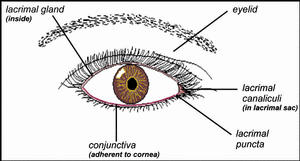|
Fifth Dimension Catalog Contact Us |
|

|
Eye Cancer Therapy Toxicity Issues
|
5-FU (5-Fluorouracil)
Background
5FU is commonly used alone or in combination with other chemotherapy agents (CMF= cyclophosphomide, methotrexate and 5-FU) for breast, gastrointestinal (GI) and genitourinary cancer. It interferes with the division of tumor and other rapidly dividing cells by preventing proper DNA duplication. Although this generally leads to tumor cell death, it also affects organs with a rapid cell turnover including those of the GI tract, skin, bone marrow and the surface cells of the eye. One common effect is inflammation of the mucous membranes (mucositis) see Mucositis - Oral, Esophageal and Gastrointestinal Problems and Solutions in the mouth, GI tract and conjunctiva in the eye.
Common Ocular Side Effects
Since 5-FU interferes with cell division, it affects the normal renewal of tissue in the eye, especially the tear duct, cornea and conjunctiva. Ocular side-effects generally start gradually 1- 2 weeks after initiation of the first 5-FU cycle and resolve within 10-15 days after they appear. Toxicity to the surface of the eye almost always goes away 2-3 weeks after stopping infusions of 5-FU. They become apparant as either symptoms on the surface of the eye, or as problems with the nerves leading to the eye muscles (neuromotility) disorders. It should be noted that the incidence of ocular toxicity due to 5-FU is quite small. However, it is important to report any unusual symptoms to your doctor. The following are the most common side-effects of 5-FU:
- These Symptoms were Reported in 25-39% of People Taking 5-FU Therapy
-
- Tearing eyes are described in 1/3 of patients treated with 5-FU chemotherapy. This symptom appears gradually after starting 5FU and resolves after termination of therapy. There may be a twofold reason as to excessive tearing:
- There is an overproduction of tear fluid in response to irritation of the cornea by 5-FU present in the tears. This creates a cycle where the eyes reflexively tear more thereby admitting even more of the 5FU to wash over, and irritate, the eyes. Furthermore, 5FU may be toxic to the tear gland, causing it secrete a higher level of drugs in the tears.
- The ducts normally draining tears from the eye to the nasal cavity where they are subsequently swallowed (nasolacrimal ducts), may become clogged. It is believed that 5-FU causes inflammation and abnormal scar tissue (fibrosis) of the tiny channels (canaliculi) and collection sac (lacrimal sac) thereby blocking tears from draining properly. Without this drainage, they spill over as tears.
- Blurred vision
- Blepharitis: red, scaly or swollen eyelids due to inflammation
- Keratoconjuntivitis: inflammation of both the cornea and conjunctiva
- These Symptoms are Much Less Common
-
- Photophobia: sensitivity to light
- Swelling and pain around the eye
- Accomodation disorders: difficulty focusing on objects near or far away
- Oculomotiility disorders: difficulty moving eye due to muscle weakness or disease
- Nystagmus: involuntary oscillatory movement of the eyeballs
- Chronic canaliculitis and stenosis: inflammation and subsequent narrowing and blockage of the canaliculi (tiny channels in tear drainage system)
- Ectopion: margin of the eyelid turns outward
- Tips for Symptom Prevention and Manangement :
-
- Early detection and management of symptoms are very important to prevent blockage of the tear drainage system and tears spilling over. Although it is unrealistic to avoid chemotherapy on account of relatively minor eye effects, it is important to be aware that side-effects may occur. These are generally manageable with regular check-ups with an ophthalmologist.
- Lid massages help to improve blood flow in small capillaries in the eyelid. This can help to reduce symptoms of swollen, tender, red or scaly eyelids associated with the eyelid turning outward (ectropion)
- Wipe the lower lids with an upward motion to prevent outward turning of the eyelid (ectropion)
- Application of topical corticosteroid-antibiotic combinations may help prevent complete blockage of tear drainage system.
- Ice packs on eyes during 5-FU injections help to minimize blood flow in the small capillaries around the eyes and therefore the concentration of 5-FU that enters the tears. This minimizes the subsequent excessive tearing from the irritation to cornea and conjunctiva.
- Discontinue wearing contact lenses before beginning treatment with 5-FU. This may prevent swelling of the cornea as lenses are difficult to remove when eyelids are swollen and tender.
- Artificial tears help to dilute the natural tears containing 5-FU. Any brand of artificial tear is recommended as long as it is not used more than four times a day.
|
You are welcome to share this © article with friends, but do not forget to include the author name and web address. Permission needed to use articles on commercial and non commercial websites. Thank you. |
